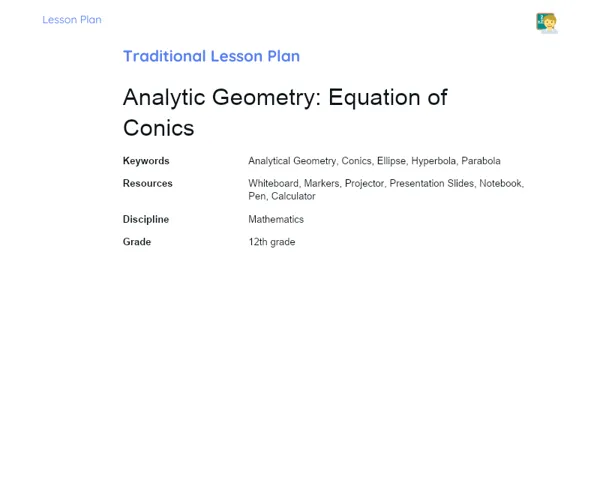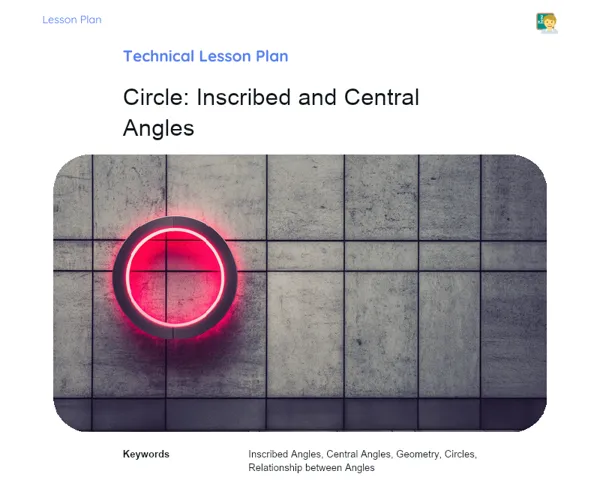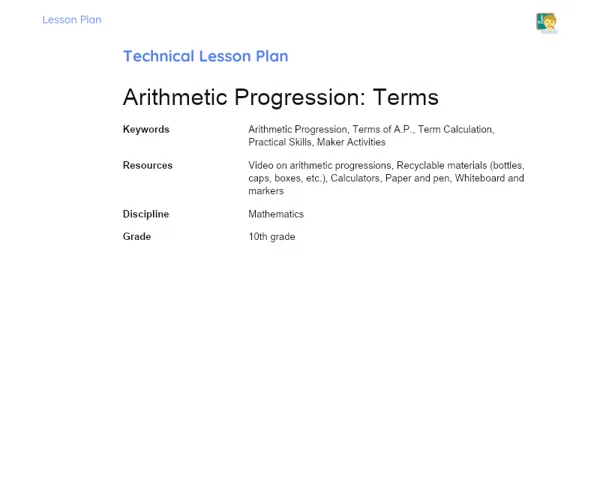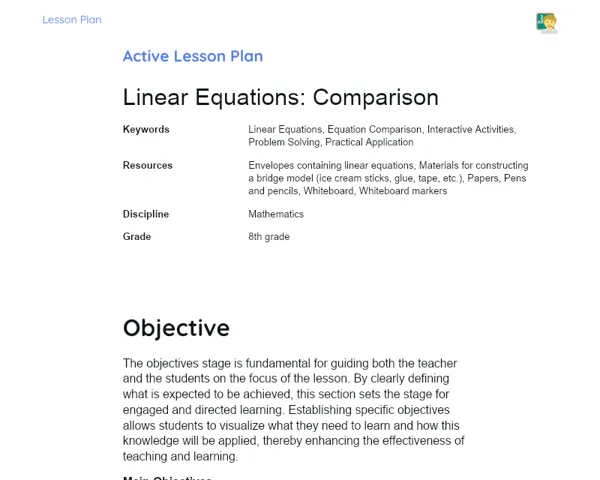Lesson Plan | Lesson Plan Iteratif Teachy | Polynomials: Operations
| Keywords | Polynomials, Operations with polynomials, Addition, Subtraction, Multiplication, Division, Digital Methodology, Social Media, Gamification, Podcast, Creativity, Teamwork, Digital Tools, Interactive Content |
| Resources | Mobile phones or devices with internet connectivity, Social media apps (Instagram, TikTok), Content creation tools (Canva, InShot), Quiz and game creation platforms (Kahoot, Quizizz, Google Forms), Audio recording and editing applications (Anchor, various audio editors), School communication platforms (Google Classroom, Microsoft Teams), Whiteboard and markers, Projector or screen for presentations |
| Codes | - |
| Grade | 12th grade |
| Discipline | Mathematics |
Goal
Duration: 10 to 15 minutes
This stage sets the core objectives that will guide the lesson. By defining these objectives clearly, we can tailor our activities and methods to ensure students gain the intended skills while staying motivated throughout the learning process.
Goal Utama:
1. Help students learn how to add, subtract, multiply, and divide polynomials.
2. Apply polynomial operations to solve real-world problems relevant to students' lives.
Goal Sekunder:
- Foster teamwork and cooperation among students during the activities.
- Use digital tools and interactive resources to enhance the learning experience.
Introduction
Duration: 15 to 20 minutes
The goal here is to hook students from the start, linking the concept of polynomials to their realities and encouraging the use of digital tools for information gathering. By discussing what they've found and responding to key questions, students will engage their prior knowledge and gear up for the practical activities ahead, fostering a dynamic and collaborative learning environment.
Warming Up
To kick off our lesson on polynomial operations, we should connect the topic to the students' everyday experiences. Briefly mention that polynomials are algebraic expressions that we encounter in various contexts, such as budgeting, physics, and engineering. Then, ask students to use their smartphones to look up an interesting piece of trivia about polynomials. They can use any apps or social media platforms they prefer to find something they find intriguing or unexpected.
Initial Thoughts
1. What exactly are polynomials, and where do we see them in day-to-day life?
2. What key operations can we perform on polynomials?
3. Why is it important to know how to add, subtract, multiply, and divide polynomials in today's world?
4. Did you come across any fascinating facts or practical uses of polynomials during your search?
Development
Duration: 75 to 85 minutes
The aim of this segment is to provide an engaging and collaborative learning experience wherein students can apply concepts of polynomial operations through practical activities set in the digital realm. By exploring modern digital tools and communication formats, students solidify their understanding creatively and meaningfully, making learning more relevant.
Activity Suggestions
Activity Recommendations
Activity 1 - Math Influencers 📱
> Duration: 60 to 70 minutes
- Goal: To enhance understanding of polynomial operations by framing learning within social media, encouraging creativity and collaborative effort.
- Deskripsi Activity: In this activity, students will form groups to create social media content (like Instagram or TikTok) that explains polynomial operations in a fun and engaging manner. This could be in the form of videos, image posts, or stories. The idea here is for each group to play the role of math influencers, using popular language and formats on social media to simplify concepts and provide practical examples of polynomial operations.
- Instructions:
-
Split the class into groups of up to 5 students.
-
Each group should select a format for their content (video, image post, or story).
-
Each group must draft a script or outline focusing on one polynomial operation (addition, subtraction, multiplication, or division).
-
Using their phones, students will film, edit, and create their content. They can leverage apps like TikTok, Instagram, Canva, etc., for effects, text, and visuals.
-
Upload the content on their chosen social media or share it with the class via a school communication platform.
-
Each group will present their work to the class, explaining their creative process and how they tackled the mathematical topic playfully.
-
Students will engage with each other’s content through simulated likes, comments, and shares.
Activity 2 - Mission: Polynomials in Gaming World 🎮
> Duration: 60 to 70 minutes
- Goal: Utilize gamification to make the learning of polynomial operations more lively and interactive, promoting collaboration and practical knowledge application.
- Deskripsi Activity: Students will take on the challenge of creating a digital game or a series of gamified challenges centered around polynomial operations. Using online platforms like Kahoot, Quizizz, or even Google Forms, groups will craft interactive activities designed for teaching and reviewing polynomial operations.
- Instructions:
-
Organize students into groups of up to 5 members.
-
Select an online tool for game or quiz creation (Kahoot, Quizizz, Google Forms).
-
Decide which polynomial operations will be addressed (addition, subtraction, multiplication, division).
-
Draft a series of questions or challenges that pertain to polynomial operations, incorporating varying difficulty levels and gamification aspects (like points or bonuses).
-
Test the created game or quiz within the group to ensure clarity and engagement.
-
Each group will share their game/quiz with the class and explain the choices and challenges they included.
-
Students are encouraged to participate in each other's quizzes, assessing the engagement and effectiveness.
Activity 3 - Math Podcast 🎙️
> Duration: 60 to 70 minutes
- Goal: Explore diverse communication methods to elucidate mathematical concepts and reinforce understanding of polynomial operations, while also enhancing research and communication skills.
- Deskripsi Activity: Students will form groups to produce a podcast episode aimed at explaining and discussing polynomial operations. The podcast should cover theoretical concepts, practical examples, and include discussions on polynomial applications in real life (like finance or physics). This task will enhance students' communication skills and allow them to deepen their understanding via oral expression.
- Instructions:
-
Divide the class into groups of up to 5 students.
-
Choose a podcast format (discussion, interview, or spoken lesson).
-
Draft a script that includes an introduction, explanations of polynomial operations (addition, subtraction, multiplication, division), practical examples, and discussions on real-world applications.
-
Use audio recording and editing apps available on their phones (like Anchor or any other audio editing software).
-
Record the podcast episode and make necessary edits for clarity and flow.
-
Share the episode with the class through an accessible platform (Google Drive, Spotify, etc.).
-
Summarize the podcast for the class, highlighting key points and examples discussed.
Feedback
Duration: 20 to 25 minutes
This stage aims to solidify learning by encouraging students to reflect and exchange experiences. Through discussing outcomes and receiving peer feedback, students deepen their insight into polynomial operations while developing vital communication and collaboration skills. It also nurtures a culture of constructive feedback that is essential for both academic and personal growth.
Group Discussion
Facilitate a class discussion where students can share their thoughts on the activities they participated in. Guide the discussion with the following structure:
- Introduction: Ask students how they felt during the activities and highlight any challenges or successes they encountered.
- Sharing: Have each group present their digital content (videos, posts, podcasts, quizzes) to the class while explaining their creative process and the polynomial operations they explored.
- Discussion: Encourage an open conversation about the varied approaches and formats employed by groups, pinpointing strengths and areas for enhancement.
- Integration: Ask students how digital tools aided in grasping mathematical concepts, and how these skills could be applicable in other subjects.
Reflections
1. What key lessons did you learn from creating and sharing digital content on polynomial operations? 2. How did digital tools and social media enrich your understanding of polynomials? 3. In what ways did teamwork enhance the success of the activities, and how could group work be improved in future projects?
Feedback 360º
Conduct a 360° feedback session where each student gives and receives feedback within their groups. Ensure students provide constructive feedback, focusing on the positives and areas to improve. You may use the following pointers:
- Positive Aspects: Encourage students to begin by recognizing the strengths of group efforts, acknowledging specific contributions from each member.
- Suggestions for Improvement: Each student should offer a tangible improvement suggestion, addressing work processes, communication, or end outputs.
- Self-Reflection: Allow each student to share a moment of self-reflection, contemplating their own involvement and how they can enhance their contributions in future activities.
Conclusion
Duration: 10 to 15 minutes
This stage aims to consolidate learning by linking the concepts discussed with students' everyday lives and contemporary relevance. By summarizing the material in an engaging manner, reflecting on its significance today, and illustrating practical applications, we reaffirm the importance of the topic and encourage students to keep exploring and implementing their mathematical skills in varied contexts.
Summary
In conclusion, think of the concepts we've learned as our mathematical superpowers! 💥 Polynomials have come to our rescue today as we learned to add, subtract, multiply, and divide them. Each operation is a special tool to efficiently solve complex challenges. 🎉 Well done on all your fantastic digital creations that transformed abstract concepts into entertaining and accessible material!
World
When we mention polynomials, we’re tapping into their connection to our modern world on multiple levels! 🚀 They play vital roles in computer algorithms, physics simulations, financial analysis, and even in crafting the animated graphics we see in films and games. Engaging with digital tools to grasp polynomials helps illuminate how mathematics permeates our dynamic daily lives.
Applications
Grasping polynomial operations is crucial across various fields. Whether it's for trajectory calculations in engineering, analyzing financial trends, or even data modeling in computer science, polynomials are ubiquitous! This knowledge empowers us to tackle complex problems and craft innovative solutions to real-world challenges.



